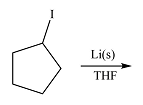
Concept explainers
(a)
Interpretation:
The product of the given reaction is to be predicted.
Concept introduction:
The C atom in the
Answer to Problem 19.1P
The product of the given reaction is

Explanation of Solution
The given reaction is

Magnesium is an active metal and reacts with the polar

Thus, the product of the reaction is phenyl magensium iodide:

The structure of the product was drawn based on reversal of the charge on the carbon atom from the
(b)
Interpretation:
The product of the given reaction is to be predicted.
Concept introduction:
The C atom in the
Answer to Problem 19.1P
The product of the given reaction is
![]()
Explanation of Solution
The given reaction is
![]()
The
![]()
In essence, the reaction inserts the metal atom between the C and Br atoms and leads to a reversal of the charge on the carbon atom.
Thus, the product of the reaction is
![]()
The product of the reaction was drawn based on the reversal of charge on the C atom bonded to bromine.
(c)
Interpretation:
The product of the given reaction is to be predicted.
Concept introduction:
The C atom in the
Answer to Problem 19.1P
The product of the reaction is

Explanation of Solution
The given reaction is

Li is a very active metal and will extract the iodine atom from the substrate. The

Effectively, the reaction results in the replacement of the iodine atom by Li atom, therefore, the product will be

The product of the reaction was drawn based on the reversal of the charge on the carbon atom initially bonded to iodine.
(d)
Interpretation:
The product of the given reaction is to be drawn.
Concept introduction:
The C atom in the
This reverses the initial polarity (charge) of the carbon, allowing it to form a bond with an electron-poor carbon from say a carbonyl carbon.
Answer to Problem 19.1P
The product of the given reaction is

Explanation of Solution
The given reaction is
![]()
The product from part (c) is cyclopentyllithium. Two moles of this compound will react with one of copper(I) iodide to form

The carbon atom in the
The product of the reactio is, therefore,

The product of the reaction was drawn based formation of a bond between the relatively electron-rich carbon atoms and the copper atom.
Want to see more full solutions like this?
Chapter 19 Solutions
EBK ORGANIC CHEMISTRY: PRINCIPLES AND M
- Determine if the following salt is neutral, acidic or basic. If acidic or basic, write the appropriate equilibrium equation for the acid or base that exists when the salt is dissolved in aqueous solution. If neutral, simply write only NR. Be sure to include the proper phases for all species within the reaction. NaN₃arrow_forwardCan I please get help with this?arrow_forwardCan I please get help with this?arrow_forward
- Use the Henderson-Hasselbalch equation to calculate pH of a buffer containing 0.050M benzoic acidand 0.150M sodium benzoate. The Ka of benzoic acid is 6.5 x 10-5arrow_forwardA. Draw the structure of each of the following alcohols. Then draw and name the product you would expect to produce by the oxidation of each. a. 4-Methyl-2-heptanol b. 3,4-Dimethyl-1-pentanol c. 4-Ethyl-2-heptanol d. 5,7-Dichloro-3-heptanolarrow_forwardWhat is the pH of a 1.0 L buffer made with 0.300 mol of HF (Ka = 6.8 × 10⁻⁴) and 0.200 mol of NaF to which 0.160 mol of NaOH were added?arrow_forward
- Can I please get help with this.arrow_forwardDetermine if the following salt is neutral, acidic or basic. If acidic or basic, write the appropriate equilibrium equation for the acid or base that exists when the salt is dissolved in aqueous solution. If neutral, simply write only NR. Be sure to include the proper phases for all species within the reaction. N₂H₅ClO₄arrow_forwardPlease help me with identifying these.arrow_forward
 Organic Chemistry: A Guided InquiryChemistryISBN:9780618974122Author:Andrei StraumanisPublisher:Cengage Learning
Organic Chemistry: A Guided InquiryChemistryISBN:9780618974122Author:Andrei StraumanisPublisher:Cengage Learning
